On July 15, 1975 at 15:20 Moscow Time, the Soyuz-19 spacecraft was launched from the Baikonur Cosmodrome. Seven and a half hours later, the Apollo spacecraft blasted off at Cape Canaveral. On July 17, the two spacecraft docked. The Soyuz-Apollo mission became the first joint space trip by astronauts from different countries.

1/15
© AP Photo / Gene J.Puskar
Contacts between Soviet and US scientists over space exploration began right after the first artificial satellites were put into orbit. However, the cooperation was limited to sharing results of scientific research during various international conferences.
Above: A display at the Smithsonian Air and Space Museum depicts the docking of the American Apollo command and service module (left) with the Soviet Soyuz capsule.
Above: A display at the Smithsonian Air and Space Museum depicts the docking of the American Apollo command and service module (left) with the Soviet Soyuz capsule.
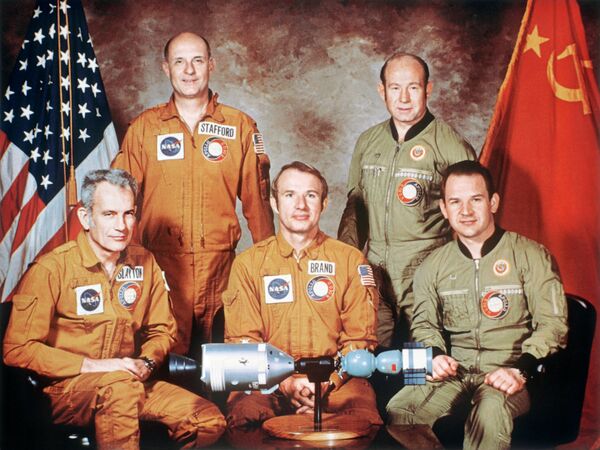
The cooperation between the USSR and the US in the field of space exploration intensified in 1970-1971 when scientists and technical specialists of both countries held a series of meetings. On October 26-27, 1970, Moscow hosted the first the joint meeting on the issue of docking manned spacecraft and space stations. By April 1972, the US and the USSR signed an Agreement Concerning Cooperation in the Exploration and Use of Outer Space for Peaceful Purposes, committing both countries to the launch of the Apollo–Soyuz Test Project (ASTP) in 1975.
Above: The Soyuz-Apollo Soviet-US space test crew: captain Alexei Leonov, right in the back row, and engineer Valery Kubasov, right in the front row, and astronauts Thomas Stafford, Donald (Deke) Slayton and Vance Brand. July 1975.
Above: The Soyuz-Apollo Soviet-US space test crew: captain Alexei Leonov, right in the back row, and engineer Valery Kubasov, right in the front row, and astronauts Thomas Stafford, Donald (Deke) Slayton and Vance Brand. July 1975.
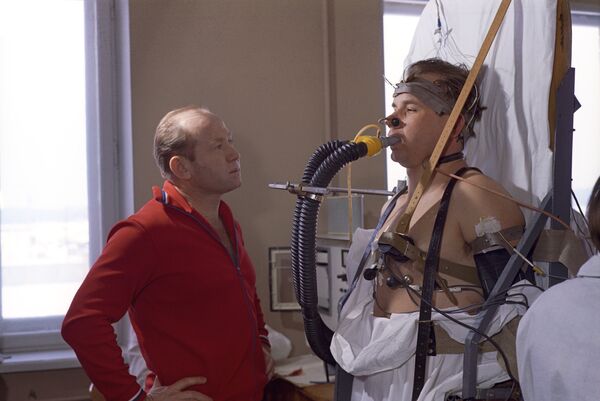
The main purposes of the ASTP project were the development of an advanced versatile rescuing device, tests of technical systems and joint flight guidance instruments, as well as conducting joint scientific experiments and research.
Above: Alexei Leonov inspecting Valery Kubasov, USSR pilot-cosmonaut's medical trial using a cycle ergometer at the Gagarin State Scientific Research-and-Testing Cosmonaut Training Center.
Above: Alexei Leonov inspecting Valery Kubasov, USSR pilot-cosmonaut's medical trial using a cycle ergometer at the Gagarin State Scientific Research-and-Testing Cosmonaut Training Center.

A brand new spacecraft docking mechanism was designed for the mission. It was called Androgynous Peripheral Attach System. In each docking there was an active and a passive side, but both sides could fulfill either role. It solved the problem of compatibility between two spacecraft in case of an emergency situation.
Above: Pilot-cosmonauts Alexei Leonov, Vance Brand, and Valery Kubasov train on a spaceship simulator at the Yuri Gagarin Cosmonaut Training Center.
Above: Pilot-cosmonauts Alexei Leonov, Vance Brand, and Valery Kubasov train on a spaceship simulator at the Yuri Gagarin Cosmonaut Training Center.
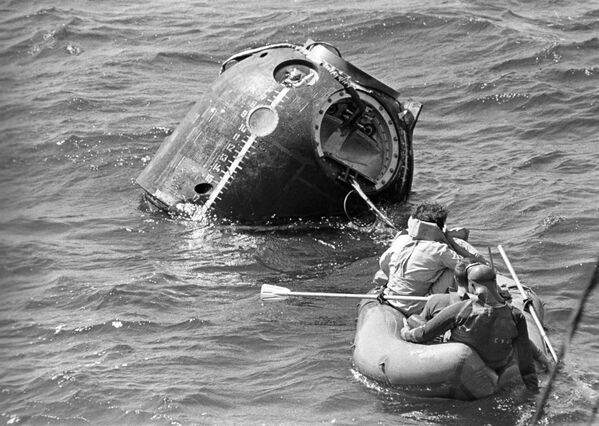
In March 1973, NASA announced the crew of the Apollo spacecraft: Thomas Stafford, Vance Brand and Donald Slayton. The backup crew included Alan Bean, Ronald Evans and Jack Lousma.
Above: Pilot-cosmonauts and Heroes of the Soviet Union Valery Kubasov (left) and Alexei Leonov in splashdown training.
Above: Pilot-cosmonauts and Heroes of the Soviet Union Valery Kubasov (left) and Alexei Leonov in splashdown training.
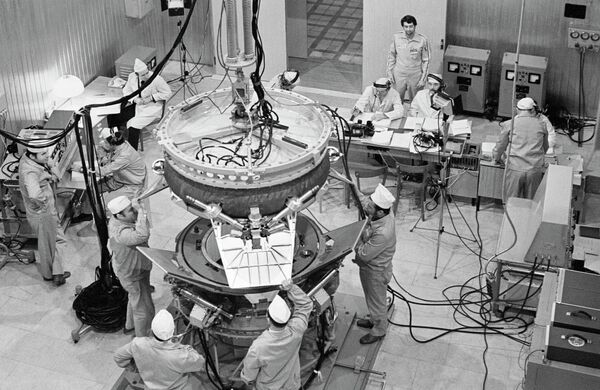
Two months later, the Soyuz crew was announced: Alexei Leonov and Valery Kubasov. The backup crew comprised Anatoly Filipchenko and Nikolai Rukavishnikov. The decision was taken that each spaceship would be directed by their home control center.
Above: Docking the Soyuz and Apollo spaceships, Space Research Institute, the USSR Academy of Sciences.
Above: Docking the Soyuz and Apollo spaceships, Space Research Institute, the USSR Academy of Sciences.
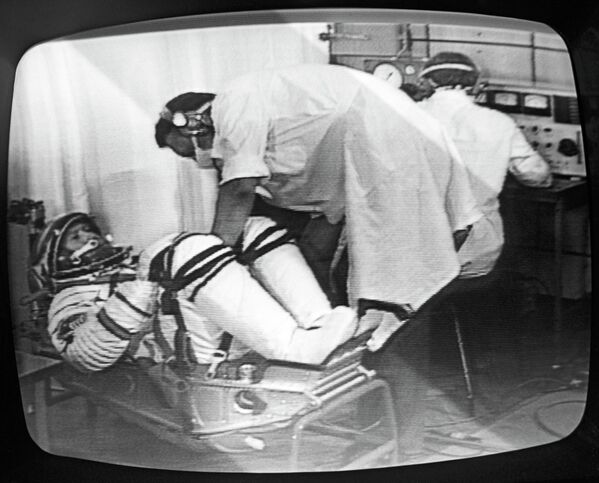
On December 2-8, 1974, under the Soviet preparation plan a test flight on the modernized Soyuz-16 spaceship was conducted. During the flight, the life support and docking systems were checked.
Above: USSR cosmonaut Alexei Leonov being inspected before the spacecraft took off. A photo from a monitor screen.
Above: USSR cosmonaut Alexei Leonov being inspected before the spacecraft took off. A photo from a monitor screen.
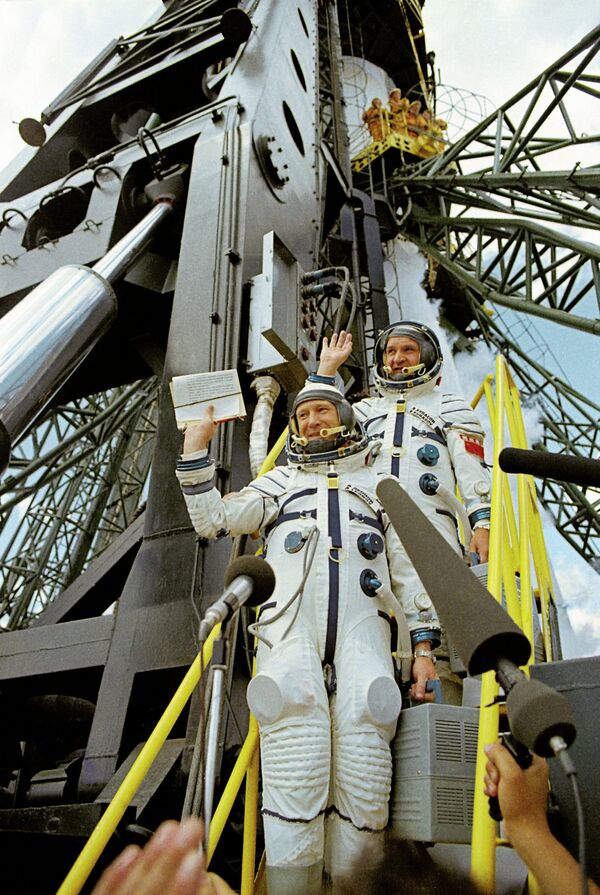
On July 15, 1975, the final stage of the test flight program kicked off. The Soyuz and Apollo flights launched within seven-and-a-half hours of each other.
Above: Soviet cosmonauts Alexei Leonov (left) and Valery Kubasov at the Baikonur space center before the launch of the Soyuz-19 spacecraft on July 15, 1975.
Above: Soviet cosmonauts Alexei Leonov (left) and Valery Kubasov at the Baikonur space center before the launch of the Soyuz-19 spacecraft on July 15, 1975.
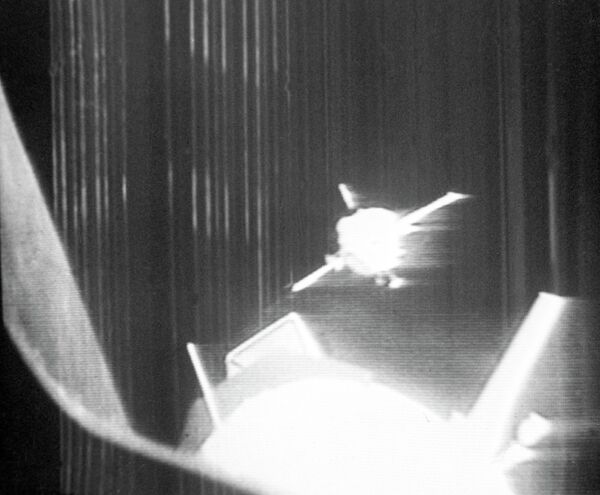
On July 16, the two crews were doing repair works. A defect in the television system was found on board the Soyuz while on the Apollo the docking system had an error. The crews managed to fully repair the defects.
Above: Soyuz-19 docks with the Apollo spacecraft during the Apollo-Soyuz Test Project. The photo from a TV screen.
Above: Soyuz-19 docks with the Apollo spacecraft during the Apollo-Soyuz Test Project. The photo from a TV screen.
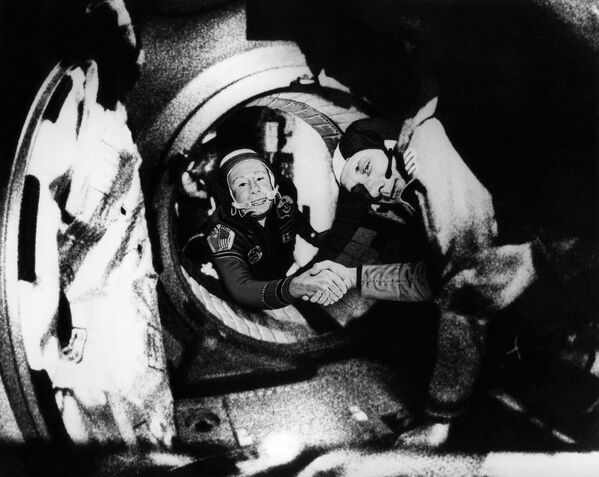
On July 17, the final stage of the rendezvous began. The docking was registered at 19:09 Moscow time. The two spacecraft docked having created a prototype for the future international space station.
Above: Commander of the Soviet crew of Soyuz, Alexei Leonov (left) and commander of the American crew of Apollo, Thomas Stafford, shake hands on 17 July 1975 in space.
Above: Commander of the Soviet crew of Soyuz, Alexei Leonov (left) and commander of the American crew of Apollo, Thomas Stafford, shake hands on 17 July 1975 in space.
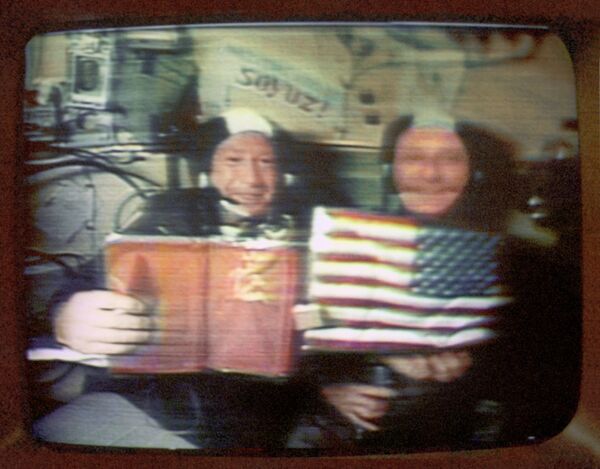
Three hours after the docking, the two mission commanders, Stafford and Leonov, exchanged the first international handshake in space through the open hatch of the Soyuz.
Above: Soviet cosmonaut Alexei Leonov, left, and US astronaut Thomas Stafford answer journalists' questions at a press conference in space during the experimental flight of Apollo and Soyuz spacecraft in July 1975. The photo from a TV screen.
Above: Soviet cosmonaut Alexei Leonov, left, and US astronaut Thomas Stafford answer journalists' questions at a press conference in space during the experimental flight of Apollo and Soyuz spacecraft in July 1975. The photo from a TV screen.
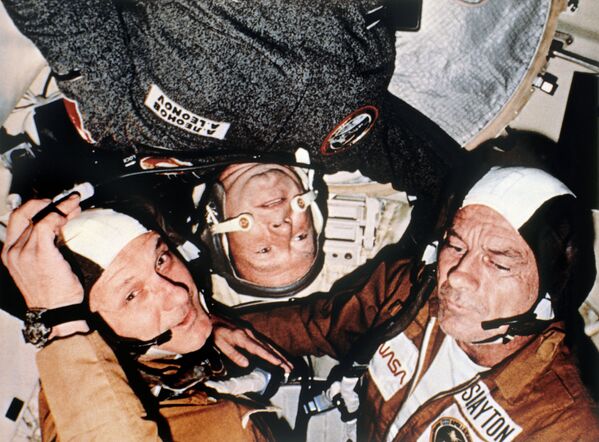
The meeting between the Soviet and US space crews were transmitted to Earth through television networks. The Soyuz and Apollo spacecraft hosted the first ever press conference in space.
Above: The Soyuz-Apollo Soviet-US space crew after docking, July 1975. Cosmonaut Alexei Leonov, center, and astronauts Thomas Stafford and Donald Slayton.
Above: The Soyuz-Apollo Soviet-US space crew after docking, July 1975. Cosmonaut Alexei Leonov, center, and astronauts Thomas Stafford and Donald Slayton.
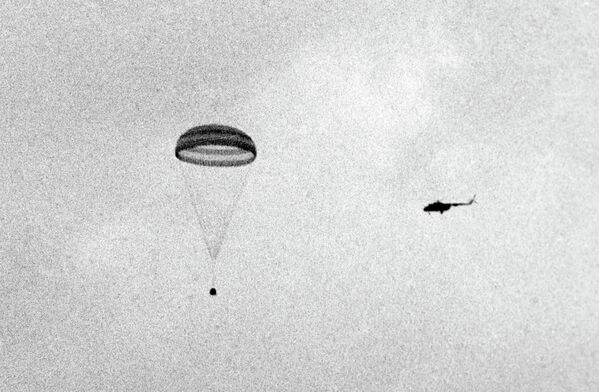
The flight of the docked spacecraft lasted for 43 hours 54 minutes and 11 seconds. The ships undocked on July 19 at 15:03 Moscow time. Then they docked one more time to test the mechanisms.
Above: The spaceship with Soviet pilot-cosmonauts Alexei Leonov and Valery Kubasov landing on a parachute in the estimated area of 54 km to the north-east of Arkalyk in Kazakhstan.
Above: The spaceship with Soviet pilot-cosmonauts Alexei Leonov and Valery Kubasov landing on a parachute in the estimated area of 54 km to the north-east of Arkalyk in Kazakhstan.
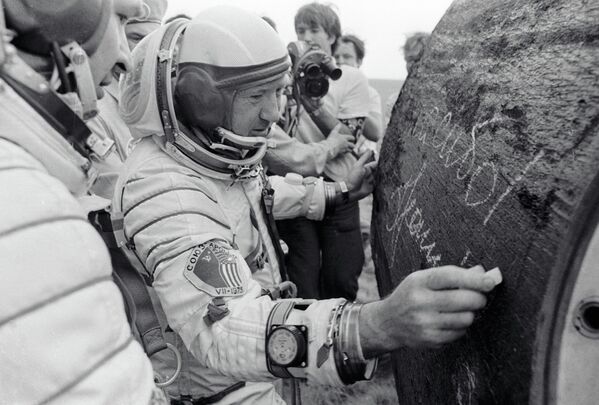
After the program was completed, Soyuz landed on July 21, 1975 near the city of Arkalyk in Kazakhstan. On July 25, Apollo landed on the water in the Pacific Ocean. The flight proved the effectiveness of docking techniques for further flights and missions. The success of the ASTP flight played a major role for international space flights under the Mir-Shuttle program as well as for the International Space Station project.
Above: Soviet pilot-cosmonaut Leonov autographing on the descent module after landing.
Above: Soviet pilot-cosmonaut Leonov autographing on the descent module after landing.
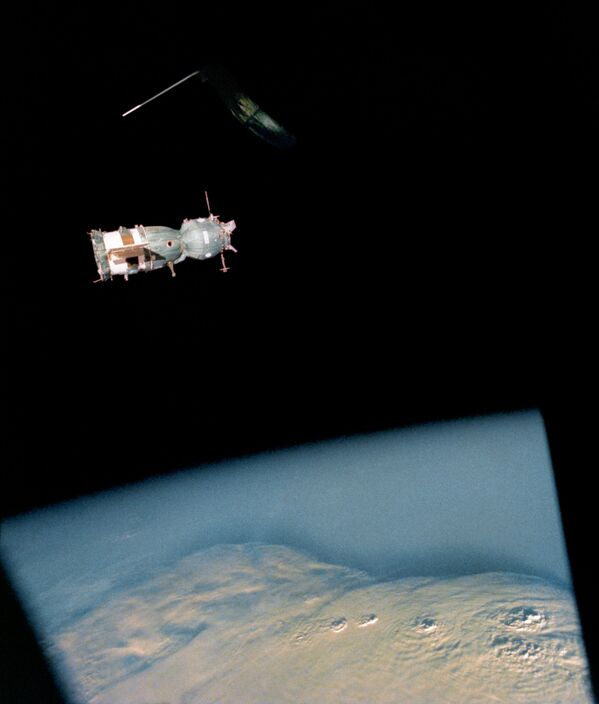
A historic photo of the Soyuz-19 spacecraft taken by the Apollo crewmembers.

